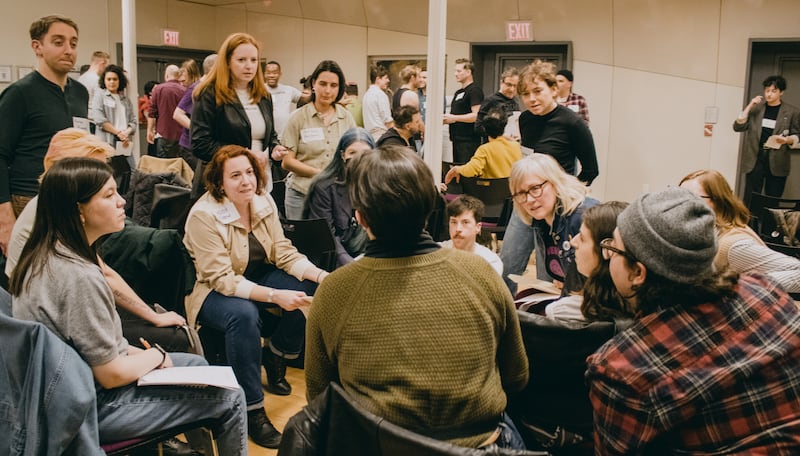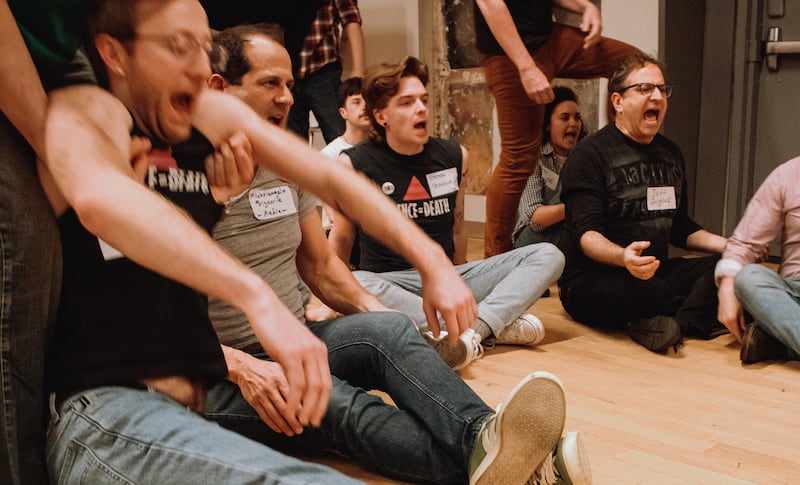The safe word was “lasagna.”
On the floor, a group of people playing demonstrators, sitting cross-legged, arms linked, were chanting, “Act Up! Fight Back! Fight AIDS!” Around them standing, ready to separate them and haul them individually out of the circle by their shoulders, was another group of people playing cops.
If playtime went south and things got too rough, the word “lasagna” would ring out.
To make things more intriguing during the self-described “theatrical experiment” of Fight Back, all the real-life people in the ground floor Room 101 of New York’s LGBT Center in were inhabiting the selves of real-life people in 1989, attending a meeting of direct action group Act Up on March 13 that year in the same room at The Center.
There are no actors in Fight Back, just participants who have signed up for this emotive evening of time travel, all of whom have been given the personas of real-life attendees at the meeting.
The protesters vs. cops set-up was part of that meeting’s “Civil Disobedience Training,” and happened that night in 1989. Just as with every other beat of the meeting, the re-imagining in 2025 is a piece of theater dependent on the fully committed participation of those who have signed up.

The golden rule, and over three hours it went unbroken, was that as soon as the participants entered Room 101 it was 1989. If you recognized a friend from 2025, sure, speak to them but in the 1989 character assigned to you. There were references to faxes, not cellphones. Occasionally, someone might say something that nodded to a future we knew, but the self-imposed spell of historical transposition remained in place until the meeting ended.
The brainchild of organizer David Wise, Fight Back is an exercise in collective responsibility as well as collective conjuring. The only thing rooting the evening are the actual minutes of that night’s meeting. As overseen by two facilitators, it was centered around planning Act Up’s “Target City Hall” demonstration on Mar. 28, 1989, to protest then New York Mayor Ed Koch’s policies, or lack of them, towards the care and treatment accorded to those with HIV and AIDS.
Act Up was famed for its loud and visually striking public demonstrations against officialdom, the media, and the church’s inaction and bigotry around people with the disease—their medical treatment, how they were cared and uncared for, and how they were stigmatized and demonized.
Amid institutions’ variable levels of silence and hostility, many hundreds of thousands of Americans died of AIDS, long before the advent of life-saving drugs. The anger of Act Up demonstrations was correspondingly raw and theatrical, a show of community strength and anger. Grief, humor, and fury swirled into the group’s battle-roars of resistance.
Wise’s planning of Fight Back—this is the third re-imagining of the 1989 meeting—is impressive in itself. Beforehand, he asks each attendee by email what level of overt involvement they would like to have. Those who want to have a verbal role are assigned a persona (with an age or gender perhaps different to your own) who spoke that night, or who was an organizer, or a facilitator. Those who want to be quieter are assigned a persona of someone who was in attendance but who didn’t have a central speaking or organizing role.
Wise gives each attendee as much information about the person they are playing as possible, so they can converse as them and search out personal friends and Act Up colleagues.
Once the meeting gets going, anyone can say anything—and they did. Some may have researched not just their parts, but the era. Some may have known it all too well. Some were feeling their way into their characters, issues, era, and the group.
There was a real-time collective edit of the design of two posters featuring Koch’s face and a bloody handprint. Every time Koch’s name was mentioned there were hisses, alongside caustic allusions to his own then-closeted sexuality (the truth revealed in this 2022 New York Times article, nine years after his death).
There were moving mentions of one Act Up member who had just died of AIDS—Griffin Gold, a founding member and past president of the People With AIDS Coalition—and another, Steve Zabel, who had recently been discovered murdered at home. There were questions about the cost and numbers of people attending a Lesbian and Gay Health conference in Montreal.
Some plans and people were applauded. Chants were practiced that would be bellowed outside City Hall. Some were smooth like, “Act Up! Stand Tall! Time to March on City Hall!” Others were more unwieldy-seeming until a group leader showed a liltingly phrased route through, for example, “Gay or Straight We Must Educate, Women With AIDS Exist.”

There was discussion about legal matters, what to do if arrested, the use of the word “abstinence,” and how snappy and discursive leaflets should be. There was widespread positive consensus around the bold design of a poster with Koch’s face and the words alongside: “10,000 New York City AIDS Deaths. How’m I doin’?”
There were jokes and laughter, and some campy cattiness to lighten the mood. The evening was a useful reminder that in both 1989 and 2025 New Yorkers are perennially ready to share an opinion, passionately. Wise does not do anything to create drama; the atmosphere and what unfolds are squarely down to the participants.
If no one breaks character, people seemed to find their characters as the evening and its debates and discussions rolled on. Mine was a member of the media committee, responsible for planning how to promote the action and members on the day of the City Hall demonstration. This was not an era of positive, or even vaguely equal, representation in mass media, and Act Up’s actions were usually memorable for their confrontational daring, such as their “Stop the Church!” protest at St Patrick’s Cathedral in 1989.
Even if 2025 isn’t mentioned, those in attendance dwell in it. The present-day’s intense challenges to minority communities are not far from mind, even in the temporary dream world of 1989 with its different though echoing set of crises and this production’s real-time interrogation of how best to face them.
In 1989, the key to Act Up’s method was in the title of this show, and its most famous chant: “Fight back.” Playing a real-life person at a real-life time of such devastation, anger, and vigor made one think of those Act Up members who died—who fought back and then fell. Tangible in the imagined air was the tangle of love, memories, planning, and potency of the room 36 years ago. But also, at the edge of one’s mind, was the thought that we’re not really back there, so what is Fight Back for now?
In 2025, the central question perhaps elicited by this willed journey into history is what targeted communities today can learn from 1989. What place does in-person collective responsibility and action have in a world transformed in so many ways by the internet? (One visible answer may lie in some communities’ current protesting of the presence of ICE and other government agencies in their streets.) As Fight Back makes its participants look to the past to discover what was done then, it asks as a silent corollary: So, what do we do now? (The next Fight Back will take place on Thursday, Oct. 30: sign-ups welcome now.)
The meeting ended with a humorous aside from Wise: “Well, there’s no easy way to come back to 2025, but you can now.” And so the participants introduced their real selves, and compared notes on this unique performance.
A group of Act Up veterans, who were there that night in 1989, attended the third Fight Back. At the end they grouped together to compare memories versus re-enactment. One told me that the real-life meetings would have been far more crowded and raucous. The room was not as smoothly, mutedly decorated as it was now. But something of the collective buzz, determination, and fight reverberated down the years. Eyes clouding over and voice clotting, he added what he was really remembering were his friends, so many people, who had died.
If anything, Fight Back is an active, vibrant memorial not just to their lives but to a vivid legacy they shaped that may prove powerful and instructive for those resolved to “fight back” today.
The post You’re the Star in Real-Life AIDS Drama ‘Fight Back’ appeared first on The Daily Beast.




